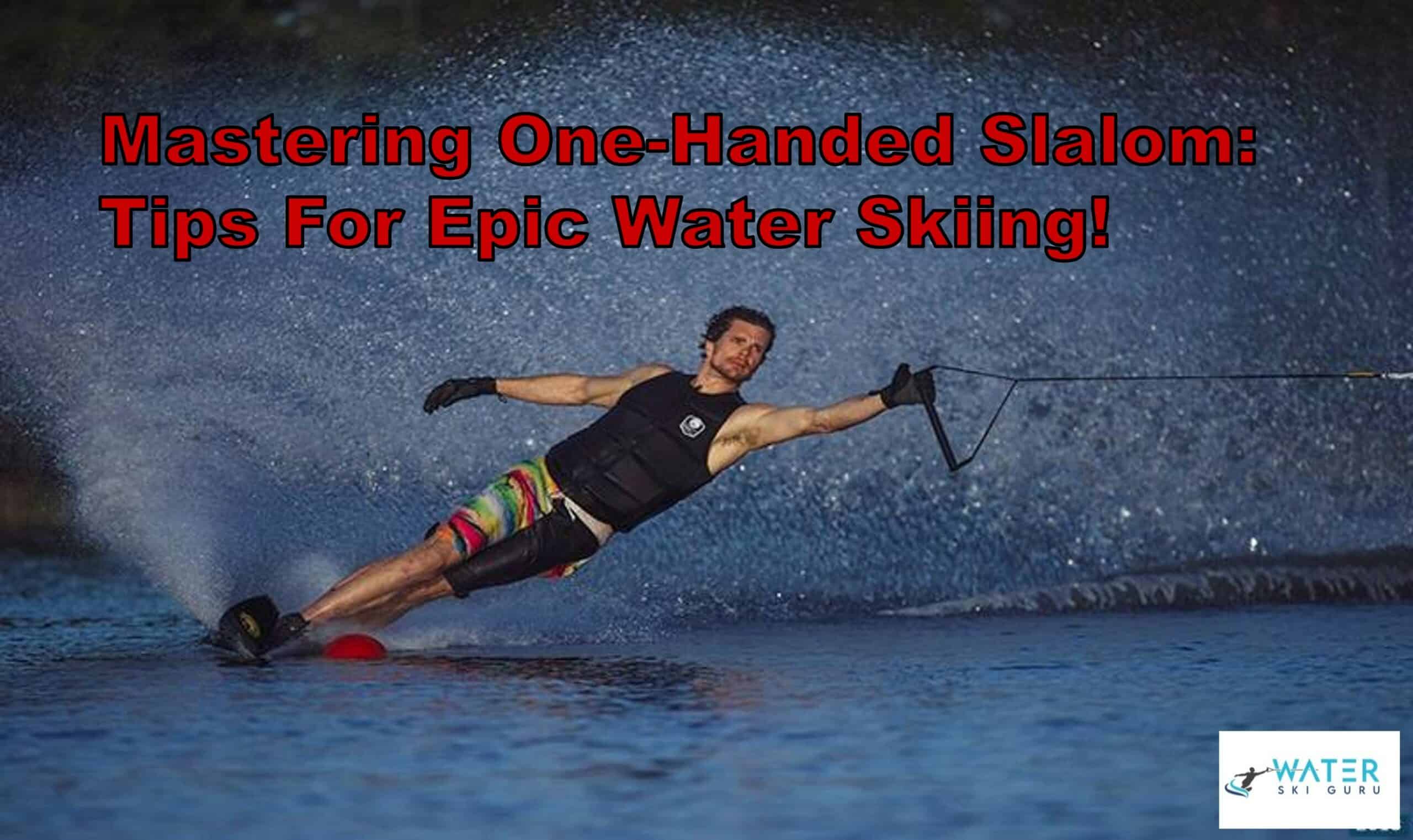I absolutely love water skiing! There’s nothing quite like the rush of gliding across the water, feeling the wind in your hair, and carving up the wake.
But as much as I enjoy skiing, I know there’s always room for improvement. That’s why I’ve been working on mastering one-handed slalom turns, an essential skill for any serious skier looking to take their skiing to the next level.
If you’re like me and want to become a true water skiing pro, then mastering one-handed slalom turns is a must. Not only do these turns give you the added length you need for rope shortenings, but they also help you avoid reduced speed and jarring from slack rope.
In this article, I’ll provide you with tips and tricks for perfecting your one-handed slalom turns, including releasing the outside hand, leaning hard on the leading outside arm, and rotating your hips away from the handle. With these techniques and a strong base position, you’ll be able to accelerate back across the wake with ease and tackle even the most challenging courses.
So, let’s get started on the path to epic water skiing!
Advancing to One-Handed
I’m excited to learn how to advance to one-handed slalom turns, as it will give me the opportunity to progress in my water skiing abilities. One-handed turns provide additional length needed for rope shortenings, as well as avoiding reduced speed and jarring from slack rope that can happen with two-handed turns. Building strength is key in order to successfully execute one-handed turns.
It’s important to start with a gradual progression, ensuring proper form and technique before advancing. Skiers should have a strong base position before introducing one-handed turns. As a beginner, I’ll start by releasing the outside hand when turning in that direction. I’ll lean hard on the leading outside arm and take up more strain on the trailing inside hand.
From there, I’ll work on rotating my hip away from the handle and counter-rotating into the turn. I’ll extend the trailing inside arm out and forward at shoulder level. By gradually building strength and technique, I can work towards mastering one-handed slalom turns.
Proper Technique
By nailing down the proper technique, I’ll be able to execute slalom turns like a pro and ride the wake like a boss. One of the most important aspects of one-handed slalom turns is hip rotation. As I approach the buoy, I need to rotate my hip away from the handle and counter-rotate into the turn. This allows me to maintain my balance and control my direction while keeping my ski on edge. Additionally, I need to release my outside arm when turning in that direction. By doing so, I can lean hard on the leading outside arm and take up more strain on the trailing inside hand. This will keep the ski turning outwards until rope tension eases up before reaching the buoy.
To help visualize these movements, I’ve created a table detailing the proper technique for one-handed slalom turns:
| Technique | Description | Importance |
| Hip Rotation | Rotate hip away from handle and counter-rotate into turn | Maintains balance and control |
| Outside Arm Release | Release outside arm when turning in that direction | Provides additional strain on inside hand |
| Trailing Inside Arm | Extend arm out and forward at shoulder level | Helps maintain balance and control |
| Latching Back On | Move free hand smoothly to outside hip and latch back onto handle after turn | Maintains control and allows for rapid acceleration |
By following these techniques and incorporating them into my one-handed slalom turns, I’ll be able to master the skill and ride the wake like a pro. With practice and dedication, I can continue to perfect my technique and achieve even greater success on the water.
Perfecting the Pass
To achieve a perfect pass, it’s crucial to ensure that my shoulders, hips, hands, and feet are all stacked in a line and I’m properly hooked up.
This means that I need to be in the correct position for rapid acceleration back across the wake.
To achieve this, I start by leaning hard on the leading outside arm and taking up more strain on the trailing inside hand when making the one-handed turn.
This helps me to maintain the correct position and balance when crossing the wake.
In addition to proper technique, I also need to focus on increasing speed and improving balance to perfect the pass.
To increase speed, I extend my trailing inside arm out and forward at shoulder level while rotating my hip away from the handle and counter-rotating into the turn.
This helps me to maintain speed and momentum when turning.
To improve balance, I keep the ski turning outwards until rope tension eases up before reaching.
This helps me to maintain my balance and avoid any unnecessary falls or accidents.
By focusing on these key elements, I can achieve a perfect pass and take my one-handed slalom turns to the next level.
Frequently Asked Questions
How do I overcome fear or hesitation when attempting one-handed slalom turns?
To build confidence and overcome fear when attempting one-handed slalom turns, mental preparation is key. Focus on proper technique and gradually work up to one-handed turns. Practice with a trusted coach and stay patient and persistent.
What type of equipment or gear is necessary for mastering one-handed slalom turns?
To master one-handed slalom turns, essential gear includes a proper fitting ski and life jacket. Proper technique involves releasing the outside hand, leaning on the leading outside arm, and rotating the hip away from the handle.
How can I improve my balance and stability on the ski during one-handed turns?
To improve my balance and stability during one-handed turns, I focus on improving my body positioning. Using visualization techniques, I picture myself stacked in a straight line, with shoulders, hips, hands, and feet aligned. This helps me stay centered and maintain control.
Are there any common mistakes or pitfalls to avoid when learning one-handed slalom turns?
Common mistakes in one-handed slalom turns include releasing the handle too early, not leaning hard enough on the outside arm, and failing to rotate the hips correctly. Correct technique involves strong base position and smooth hand transitions.
How can I incorporate one-handed turns into my overall water skiing routine or practice?
To incorporate one-handed turns, first master strong base position. Benefits for advanced skiers include extra length for rope shortenings and avoiding jarring from slack rope. Techniques for smooth transition between one and two-handed turns include releasing outside hand and rotating hips away from handle.
Conclusion
In conclusion, mastering one-handed slalom turns is an essential skill for any water skier looking to take their skiing to the next level. By releasing the outside hand, leaning hard on the leading outside arm, and rotating your hips away from the handle, you can execute smooth, efficient turns and avoid the reduced speed and jarring from slack rope.
Remember to maintain a strong base position and keep your weight centered over your ski to ensure maximum stability and control. As with any skill, practice makes perfect. Don’t be discouraged if you don’t get it right away – keep working on your technique and gradually increase your speed and difficulty.
With dedication and perseverance, you’ll be able to tackle even the most challenging courses and impress your fellow skiers with your epic one-handed slalom skills. In the world of water skiing, it’s often said that ‘the proof is in the pudding’– in other words, the true test of your skills is in your performance on the water.
So don’t be afraid to take on new challenges and push yourself to the limit – with the right techniques and plenty of practice, you’ll be able to achieve your water skiing goals and become a true master of the sport.

